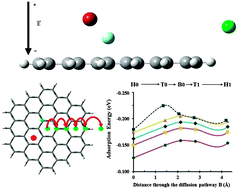Selective separation behavior of graphene flakes in interaction with halide anions in the presence of an external electric field†
Abstract
The adsorption of halide anions in the absence, and presence, of a perpendicularly external electric field on the C54H18 graphene surface has been investigated using M06-2X/6-31G(d,p) density functional theory (DFT). The structural characteristics, charge transfer, electric surface potential (ESP) maps, equilibrium distances between ions and the graphene surface and dipole moments of the ion–graphene complexes were investigated. The optimized structures show that halide anions (F− and Br−) adsorb on the graphene surface in contrast to the chloride anion that was stabilized on the edge area of the graphene flake. To clarify this unexpected behavior, diffusion of the chloride anion on the graphene surface was analyzed. The observations suggest that the moving of the chloride halide anion between barrier energies on the graphene flake has been facilitated as a result of the applied external electric field. In addition, an effective anion-π interaction between the fluoride anion and the graphene surface in the presence of an electric field holds out the capability of these anion–graphene complexes to design anion-selective nanoscale materials.


 Please wait while we load your content...
Please wait while we load your content...